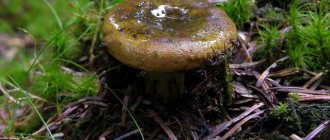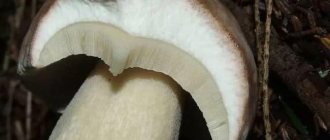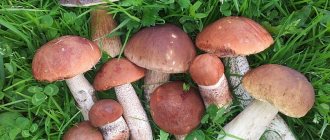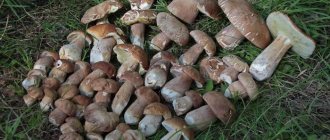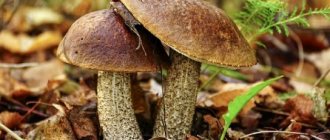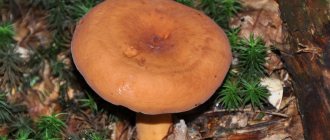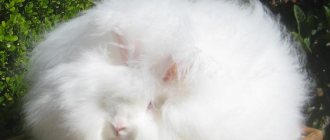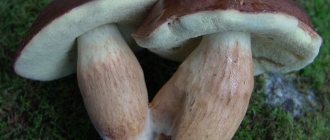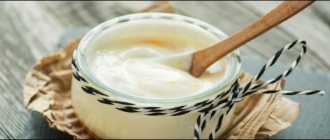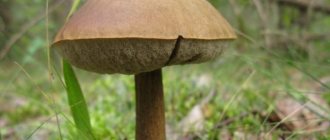3.4 / 5 ( 7 votes)
Mushroom pickers rightfully consider boletus, one of the representatives of the Boletaceae family, to be the most valuable “forest delicacy”. It is difficult to compare with other types of similar products: the fact is that this mushroom has exquisite taste, and its nutritional value lies in the fact that it is characterized by such a feature as rapid absorption in the human body.
Despite the fact that people have known the boletus mushroom for a long time, it continues to be confused with the false inedible porcini mushroom. This happens because it is difficult to distinguish it from the real thing, and quite often it becomes the cause of numerous poisonings. It should be noted that the insidious counterparts of healthy delicacies are, first of all, gall and satanic mushrooms. Therefore, in order to avoid all sorts of troubles - including hospitalization - you should learn to distinguish one from the other.
The specimens, which are popularly called “gorchaki”, received this name because of their bitter taste. In this regard, the false boletus - gall mushroom - is not poisonous, but cannot be used for cooking and canning.
This species looks exactly the same as the original: it has a thick stem and a large cap, up to 15 cm in diameter, which becomes slightly sticky when exposed to rain moisture. Please note that in young specimens the tops have a slightly convex shape, and over time they acquire a flatter surface. The color of the thick caps of these false porcini mushrooms can vary from chocolate yellowish to deep brown. The legs, in turn, can grow up to 10 cm in length and have a shade of soft cream or pale brown. A characteristic feature is also the mesh of dark shades running across the top of the mushroom.
Description of the false porcini mushroom
Gorchak (gall mushroom) is inedible. It cannot be used in cooking, and this is not only due to the unpleasant taste. In appearance, it is very similar to a real boletus, so inexperienced mushroom pickers often confuse them.
What does bitterling look like?
The structure of the bitter mushroom is almost identical to that characteristic of the true porcini mushroom. Main parameters:
- Leg. It grows to 5-13 cm in height and 1.5-3 cm in thickness. Its upper part is usually colored creamy yellow or whitish. The surface is decorated with a brown or blackish mesh, the base is swollen and fibrous. Its main part is cylindrical or club-shaped.
- Hat. In young fruits it is hemispherical, but as it matures it becomes more prostrate and rounded-cushion-shaped features appear. In dry weather, the cap surface is slightly pubescent, but during rain it becomes slippery. Its shade can be yellowish-brown, dark brown, gray-ocher.
- Pulp. It is whitish in color and has a rather impressive, massive appearance.
Important! Gorchak is widely used in folk medicine as an effective choleretic agent. But it cannot be used as a nutritional element, and the point is not only the bitter taste, which disappears after 12 hours of soaking. It still contains toxins that can seriously harm liver health.
Places of distribution
Favorite places for bitterlings to grow are:
- conifers;
- sandstones;
- zones with light loamy or slightly acidic fertile soil.
Sometimes bittergrass can be found on half-rotten stumps or tree bases. Such fruits usually grow in groups, but can also settle individually. The period during which mushrooms can be found lasts from the beginning of summer to the end of September (or until the onset of the first frost).
Where and when do bitterlings grow?
The distribution area of gall mushrooms is quite wide, as well as its edible counterparts - boletus and boletus. They are found in the forests of Europe and Asia, North America. In Russia - in the Caucasus, Western and Eastern Siberia. Gorchak grows in the middle zone, in coniferous, mixed, deciduous forests, is unpretentious and forms mycorrhiza with many tree species.
As a rule, false whites grow singly or in pairs, but can unite in small colonies (5-10 pieces). They prefer sandy soils and can grow on rotten wood - stumps, trunks, especially in the dry season.
The fruiting period of the gall fungus varies depending on the region of growth:
- Fertility occurs throughout the forest zone in June-July (usually in the middle of the summer season), ending in September-October.
- Where autumn comes early, the lifespan of mushrooms decreases, but only slightly. After mid-October you won't see them anymore.
How to distinguish a real porcini mushroom from a false one
When collecting true boletus mushrooms, especially if you do not know what their counterparts are, you should not be guided only by their appearance. Often, in order to distinguish a real fruiting body from a false one, it is necessary to carry out certain additional procedures.
Remember!
The main criterion by which bitter bitter is distinguished from a true white fruit is taste. Its counterpart is bitter, which is why it got its name. But since it is strictly forbidden to try unfamiliar mushrooms, this option for recognizing inedible mushrooms disappears immediately.
You shouldn’t immediately be at a loss as to whether it’s possible to eat a mushroom that a novice mushroom picker comes across in the forest. To understand whether it is bitterling or boletus, you need to carry out the following tests:
- Cut the fruit with a knife and pay attention to the color of the pulp that is adjacent to the ground. For a true boletus, it will remain unchanged. At the same time, in bitterling it will immediately begin to darken. The hue will become pinkish-brown, and this should be the reason for refusing to further collect such fruits.
- Examine the stem of the plucked fruiting body. A real boletus does not have the characteristic mesh that its double has. But the birch tree may still have dark scales on the stem, similar to the color of a birch trunk.
- Examine the bottom of the mushroom cap. The bitterling has a tubular layer of a dirty pink color, while the boletus has a tubular layer that is white, grayish or yellow.
Helpful advice!
You can also pay attention to the condition of the pulp and mushroom cap. Boletuses have a pleasant smell and taste, which is why forest insects, animals and worms love them. For this reason, their flesh often shows passages or damage characteristic of bites. But mustard has a pungent, bitter taste, so almost always such mushrooms remain untouched.
Useful and healing properties
The mushroom body is used in industry: pharmacology, food, cosmetology, so it has:
- Dietary properties – low energy value (34 kcal)
- ability to stimulate the secretion of the digestive glands
- tonic properties
- regulation of immune processes
- Destruction of germs
- Reducing cholesterol
- regeneration
- antioxidant
- external healing
- Prevention of oncology.
- Diet therapy for tuberculosis
Varieties of mushrooms similar to porcini
There are several other varieties of fruits that are similar to boletus. But not all of them are as dangerous as bitterweed. Some mushrooms can be used in cooking.
White breast
White milk mushrooms have a flat, then funnel-shaped cap, the color of which can vary from milky white to yellowish. There is a small but noticeable fringe along the edges of the hat section.
The fetal leg is thick and has a cavity inside it. The flesh is white in color, and if you cut it, a milky juice begins to stand out, which has a very pungent taste and tends to quickly turn yellow when exposed to air. The flesh of the mushroom is whitish and smells like fruit.
In Europe, this fruit is considered inedible, but in Russia it is widely used for pickling.
Le-Gal's boletus Rubroboletus legaliae
White mushroom and its dangerous or inedible counterparts
A mushroom from the genus Rubroboletus, family Boletaceae, also known as the Legal Boletus.
Appearance
The hat is up to 15 cm in diameter, initially convex, and later hemispherical - spread out in shape. Painted in pink and orange shades.
The hymenophore is tubular-type, the tubes are colored red. Spore powder is olive-brown.
The leg is thick and swollen, up to 16 cm high and up to 5 cm thick, painted in shades of red, with a reddish mesh in the upper part.
The pulp is whitish or light in color and turns blue when cut. It has a mild taste and a pleasant mushroom smell.
Where and when does it grow
It grows from June to September, mainly in deciduous forests. Forms mycorrhiza with beech, hornbeam and oak, prefers alkaline soils.
Can it be eaten?
The mushroom is officially considered inedible and even poisonous, although there is no specific information about the toxins it contains.
How to distinguish from Borovik
This mushroom, as well as other false boletus mushrooms with a red color, can be easily distinguished by the color of the stem and the red mesh on it.
Mushroom that turns blue when cut
Mushrooms that turn blue when cut and thus differ from true boletus are beautiful boletus and speckled oak.
Boletus is beautiful
The beautiful boletus can have different colors of the cap section:
- light brown;
- olive-light brown;
- brown;
- grey-brown.
The surface is smooth, dry, matte, sometimes wrinkled. The diameter of the cap can be 4-15 cm.
In young fruits, the stem is barrel-shaped, then becomes club-shaped or cylindrical. It can grow up to 3-15 cm in length and from 1 to 4 cm in thickness.
The pulp is quite dense and hard. It has a light cream color, but turns blue when cut. The taste of the mushroom is very bitter and pungent, so it is not eaten.
Speckled oakweed
Main characteristics of speckled oakwood:
- Hat. It has a pillow-shaped or hemispherical shape, does not exceed 5-20 cm in diameter. Its surface is matte, velvety, dry. But in some fruits it is mucous. The color can vary from dark brown to dark brown. If you press on the flesh of the cap, it will become darker or bluish.
- Leg. Quite wide, thick and massive. The shape is tuberous, cylindrical or barrel-shaped. Its length is 5-15 cm, thickness - 1.5-4 cm.
- Pulp. The color is bright yellow or yellowish, has no pronounced smell or taste. When cut, it immediately begins to turn blue.
On a note.
Speckled oak trees love acidic soil. You can find them in places where spruce, beech, oak, and fir grow.
boletus
The cap of this mushroom is grayish, brownish or brown. It looks like a swollen pillow, and reaches 4-12 cm in diameter. The leg has a white or grayish color and is scaly. Its thickness is 1.5-4 cm and tapers towards the top.
Real boletus is suitable for consumption. But it is very similar in appearance to the gall fungus, so it is important to be able to distinguish between these species.
Boletus net
Sometimes this fruit is called one of the varieties of true boletus, suitable for consumption. In principle, this mushroom is also edible, very tasty and even valued almost as much as white mushrooms.
The cap of a young mushroom is initially hemispherical, but as it matures it becomes convex. Diameter from 6 to 30 cm. The skin is colored brown. Its surface is matte and velvety. At first dry, with age it becomes covered with many cracks.
The pulp is highly dense, fleshy, and does not change color when cut. The leg is also dense and thick, brownish in color and decorated with a large mesh pattern. The mushroom has a characteristic smell and a nutty or sweetish taste.
Bronze boletus
The cap of young mushrooms is dense and hard, but noticeably softens with age. The leg has a uniform structure. Its height varies between 9-12 cm, and thickness - 2-4 cm. If you cut the flesh of the leg, it will darken noticeably, but blueing is not typical for it.
Satanic mushroom
The satanic mushroom is a poisonous fruit, although some sources call it conditionally edible. It has a cushion-shaped cap, 10-20 cm in diameter. In color, it can be grayish-white or pale ocher-white with an olive tint added. Dry to the touch, quite dense and fleshy.
The flesh is white and immediately begins to turn blue when cut. It has a faint spicy odor in young mushrooms. The leg grows in height from 6 to 10 cm, is bordered with a mesh pattern, and has an unpleasant odor, especially in more mature fruits.
On a note.
The satanic mushroom is often confused with the edible oak mushroom. Therefore, when collecting such fruits in areas where oak trees grow, special care must be taken.
Growing
Many valuable mushrooms are grown in artificially created conditions, such as boletus, boletus and boletus. Not eaten, they can also be planted in garden beds and subsequently used for pharmaceutical purposes. But this does not apply to bitter. There is no point in purposefully growing a mushroom, and only gourmets or inexperienced mushroom pickers can collect this specimen in the forest for serving. Even in the absence of a decent harvest, you should not pay attention to the gall fungus.
Beginner mushroom hunters are advised to avoid false porcini mushrooms. It is not easy to prepare, there is a risk of poisoning, and the strong unpleasant taste will discourage you from eating bittersweet. These representatives of mushroom cultures can easily be confused with a white one because of the shape of the cap and a boletus because of its color. They are found in the same places. But some bright differences will help you identify the inedible false white and not bring this dubious trophy from the forest.
0
2
Copy link
Why is false white mushroom dangerous?
The danger of such a fruit lies in its inedibility. However, bittersweet does not contain poisons as such, although it can still cause poisoning. Another distinctive feature of this species is the presence in its composition of toxins that destroy liver cells.
But it is impossible to be poisoned by gall fungus immediately after it enters the body. Firstly, due to the most unpleasant taste of this fruit, it is simply unrealistic to eat it in large quantities. Secondly, to provoke serious intoxication, a high concentration of toxic elements must enter the blood.
Symptoms and first aid for poisoning
You may be interested in: How do edible talkers differ from false mushrooms? How many days after rain do mushrooms grow? Bitter mushroom: photo and detailed description
Mushroom poisoning is difficult, but possible, and in this case it is necessary to know how it manifests itself. The first symptoms may appear after a few days or weeks, and be accompanied by:
- dizziness;
- weakness;
- nausea;
- bitterness in the mouth;
- discomfort in the liver area;
- loss of appetite;
- vomiting;
- abdominal pain;
- diarrhea.
All these symptoms are directly related to toxic liver damage. Despite the fact that the condition often stabilizes on its own, experts say that if such ailments are not paid attention to, then over time the situation can only worsen, since bitter bitter poisoning can lead to hepatitis.
There are no specific first aid measures in this case - only a doctor can help. If necessary, you can drink Regidron solution at home, and also use activated carbon to absorb toxins.
But all further activities can be carried out exclusively by a specialist. In some cases, detoxification therapy may be necessary, as well as a number of procedures aimed at eliminating hepatological complications after consuming bittersweet.
First aid
It should be remembered that poisoning can be caused not only by mycotoxins contained in the pulp of poisonous mushrooms. Toxic effects on the body are also observed when edible mushrooms are used as food after long-term storage, as well as fruiting bodies affected by mushroom flies.
Before receiving qualified medical care, you must:
- put a poisoned person to bed;
- perform gastric lavage using a light pink solution of potassium permanganate;
- if it is impossible to lavage the stomach, use a laxative and do a cleansing enema;
- save used dishes with mushrooms.
A poisoned victim must be taken to a medical facility as quickly as possible. Remember: the abuse of mushrooms, even of the first category, can harm the body, since they are hard-to-digest foods that can, under certain circumstances, cause symptoms similar to intoxication of the body.
